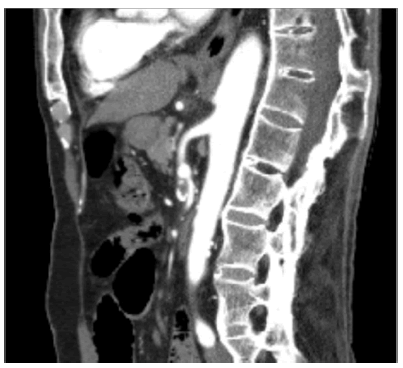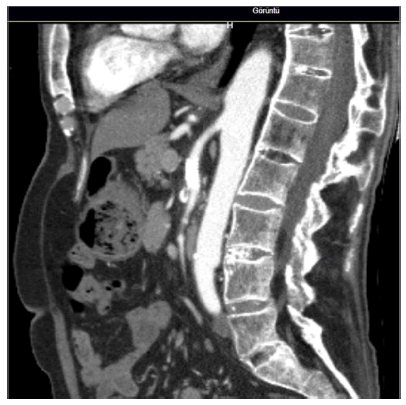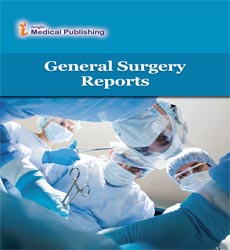Endovascular Repair of SMA Aneurisma
Sami Benla A
Mersin University, Turkey.
- *Corresponding Author:
- Sami Benla A Mersin University, Turkey; Tel: 905062314791; E-mail: benlisami@outlook.com
Received Date: September 30, 2021; Accepted date: August 20, 2021; Published date: August 29, 2021
Citation: Sami Benla A (2021) Endovascular Repair of SMA Aneurisma. Gen Surg Rep. Vol.4, No.5.
Abstract
Intestinal angina is a rare condition that affects the quality of life, characterized by abdominal pain that starts suddenly meals. It was described by Goodman in 1918. Because of the slow course of the disease, it is diagnosed late (3). Although surgery is seen as the main treatment this period; angioplasty and stent have become a surgery. Regardless of the procedure chosen, the main goal in treatment is to provide adequate blood to the structures. Although various other causes such as causes, collagen vascular diseases, trauma and arterial dysplasia are in the suggested that the most important factor underlying aneurysm is atherosclerosis. In this study, a case of SMA aneurysm treated with endovascular without the need for surgical treatment, its diagnosis and treatment are presented in the light of the literature.
Background
Visceral artery aneurysms (VAA) are rarely seen among vascular aneurysms with an incidence of 0.1% (1). SMA aneurysms are in the 3rd rank among all VAA after abdominal aorta and splenic artery aneurysms and constitute 3.2% of all VAA and are generally seen in the proximal 5 cm of the artery (2).
Intestinal angina is a rare condition that affects the quality of life, characterized by abdominal pain that starts suddenly after meals. It was first described by Goodman in 1918. Because of the slow course of the disease, it is diagnosed late (3).
Although surgery is seen as the main treatment after this period; angioplasty and stent applications have become an alternative to surgery. Regardless of the procedure chosen, the main goal in treatment is to provide adequate blood flow to the intestinal structures. Although various other causes such as infectious causes, collagen vascular diseases, arthritis, trauma and arterial dysplasia are defined in the etiology, it has been suggested that the most important factor underlying aneurysm is atherosclerosis.
In this study, a case of SMA aneurysm treated with endovascular stenting without the need for surgical treatment, its diagnosis and treatment are presented in the light of the literature.
Case presentation
A 65-year-old male patient who applied to the emergency department with the complaint of epigastric pain had previously had the same type of complaint. There was no pathological finding in the physical examination of the patient with a history of hypertension. Abdominal ultrasonography revealed no pathological findings, and abdominal intravenous contrast-enhanced tomography was performed because his complaints did not regress. Tomography revealed aneurysmatic dilatation and thrombus in the SMA approximately 4 cm distal from the orifice. Since it is a minimally invasive method and has a low mortality compared to surgery, an endovascular stent was applied to the patient's SMA by the Interventional Radiology clinic, and antiaggregant treatment was started. In the abdominal CT performed after stenting, the stent was observed in the middle part of the SMA and it was found that the SMA branches showed normal filling. It was observed that the patient did not have any complaints in the control performed in the third month after the procedure.
Figure 2:CT image of SMA aneurysm after stent placement
Discussion
Superior mesenteric artery (SMA) aneurysm is a very rare visceral vascular pathology that has the risk of rupture and can result in high mortality when rupture occurs. SMAA’s are usually found within the first 5 cm from the onset of SMA and can be fusiform or saccular (4).
Chronic mesenteric ischemia (intestinal angina) is defined as chronic post-prandial abdominal pain caused by intestinal hypoperfusion. The clinical course of the disease differs. Unlike other aneurysms, it is equally affected in men and women, but a higher risk of rupture is reported in men.
Patients can present with a variety of symptoms such as abdominal pain, nausea, vomiting, pulsatile mass or gastrointestinal bleeding. Mycotic aneurysms are usually accompanied by fever, abdominal pain, and pulsatile mass. There is a pulsatile mass in 50% of symptomatic patients. Acute presentation (ischemia and rupture) is defined in 38% of patients (5). Post-rupture mortality rate is close to 35%. 8 In a study by Stone et al., 48% of the cases were reported by Jiang et al. 70% of them were asymptomatic in their study (6). Embolism and rupture may result in serious consequences such as acute mesenteric ischemia and fatal massive bleeding. In the same study conducted by Stone et al., Rupture was found in approximately 38% of SMA aneurysms at their first admission and mortality was found to be 40% to 60% (7).
There is no typical SMAA age of onset that primarily depends on the cause of the disease. Most patients with mycotic aneurysm are under the age of 50, and patients with atherosclerotic aneurysm are usually in their seventh or eighth decade (5). Although a 50% reduction has been defined for infectious causes in the recent literature, the visceral artery remains the most affected by SMA infections (8).
Atherosclerosis is the most common cause of intestinal angina. It does not create a clinic in every patient with atherosclerosis. However, many authors believe that atherosclerosis may be a secondary process (9). Other risk factors include diabetes, hypertension, renal failure, trauma, cardiovascular diseases, vasculitis, infectious causes and smoking (10). In a study conducted by Jiang et al., No etiological cause was found in most patients (11).
In our patient, no additional pathology was found except hypertension. Biochemical and hematological routine parameters of the patient were within the normal range like the other cases in the literature. Therefore, imaging techniques are important in diagnosis.
With the increasing use of cross-sectional imaging, SMA aneurysms have been increasingly detected. Aneurysms are imaged with color duplex ultrasound, conventional angiography, magnetic resonance angiography, or computed tomography scanning. While non-invasive USG is preferred, CT angiography is the most commonly used diagnostic tool because it detects accompanying organ pathologies and has high sensitivity and specificity rates. Conventional angiography is the gold standard in diagnosis, with the ability to examine the entire vascular bed and allow intervention (balloon angioplasty, etc.) when necessary (12).
In our patient, there was no pathological finding in the abdominal ultrasonography. As the medical treatment did not improve his complaints, abdominal intravenous contrast-enhanced tomography was performed. Tomography revealed aneurysmatic dilatation and thrombus in the SMA approximately 4 cm distal from the orifice.
There is no consensus on the diameter and location, which are accepted as criteria in the treatment of visceral artery aneurysm. Asymptomatic patients with a small aneurysm (1.2 cm and 1.4 cm in size) can be observed.12 However, symptomatic or rapidly growing aneurysms with a diameter greater than 2 cm should be treated (13). In our case, the aneurysm diameter was 15 millimeters.
The primary goal of treatment is to keep the aneurysmal sac out of the bloodstream. For this purpose, percutaneous embolization and stent, or endovascular angioplasty and / or stent can be used in cases of occlusion. These treatments have a high success rate and the low mortality rate (4% versus 14%) are the reasons for preference (14). It also provides shorter hospital stays, fewer complications and better perioperative quality of life.
In our patient, an endovascular stent was applied to the SMA by the Interventional Radiology clinic, and antiaggregant treatment was started. On angio CT performed after stenting, the stent was observed in the middle part of the SMA and it was found that the SMA branches showed normal filling.
Surgical treatment is more effective in long segment occlusions, multiple vascular diseases, small vessels and severe calcifications (15). Bypass application can be done antegrade or retrograde in these patients.
Conclusion
SMA aneurysm with a high risk of mortality is an extremely rare visceral vascular pathology that should be considered in the differential diagnosis of abdominal pain. However, endovascular stent placement with a timely invasive radiological minimally invasive procedure can be successfully used as an alternative to surgical treatment in SMA aneurysm.
References
- Grotemeyer D, Duran EJ, Park N, Hoffmann D, Blondin F, Iskandar F, et al.(2009) Visceral artery aneurysmsdfollow-up of 23 patients with 31 aneurysms after surgical or interventional therapy. Langenbecks Arch Surg; 394:1093-2000
- Pulli W, Dorigo N, Troisi N, Pratesi AA. (2008) Surgical treatment of visceral artery aneurysm: a 25-year experience. J Vasc Surg; 48:334-42
- DeBakey ME, (1953) Cooley DA. Successful resection of mycotic aneurysm of superior mesenteric artery: Case report and review of literature. Am Surg.; 19:202–212.
- Messina LM, Shanley CJ.(1997) Visceral artery aneurysms. Surg Clin North Am.; 77:425–442.
- Kopatsis A, D'Anna JA, Sithian N, Sabido F. (1998) Superior mesenteric artery aneurysm: 45 years later. Am Surg ; 64:263–266.
- Stone WM, Abbas M, Cherry KJ, Fowl RJ, Gloviczki P.(2002) Superior mesenteric artery aneurysms: is presence an indication for intervention? J Vasc Surg; 36:234-7.
- Zelenock GB, Stanley JC. (2000) Splanchnic artery aneurysm. In: Rutherford RB, editor. Vascular surgery. 5th ed. Philadelphia: W. B. Saunders; 1369-82.
- Ohmi M, Kikuchi Y, Ito A, Ouchi M.(1990) Superior mesenteric artery aneurysm secondary to infectious endocarditis. J Cardiovasc Surg (Torino);31:115–117.
- Stanley JC, Wakefield TW, Graham LM, Whitehouse WM Jr, Zelenock GB, Lindenauer SM.(1986) Clinical importance and management of splanchnic artery aneurysms. J Vasc Surg; 3:836-40.
Open Access Journals
- Aquaculture & Veterinary Science
- Chemistry & Chemical Sciences
- Clinical Sciences
- Engineering
- General Science
- Genetics & Molecular Biology
- Health Care & Nursing
- Immunology & Microbiology
- Materials Science
- Mathematics & Physics
- Medical Sciences
- Neurology & Psychiatry
- Oncology & Cancer Science
- Pharmaceutical Sciences


